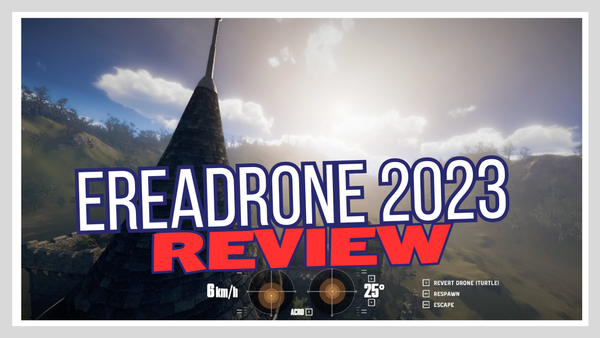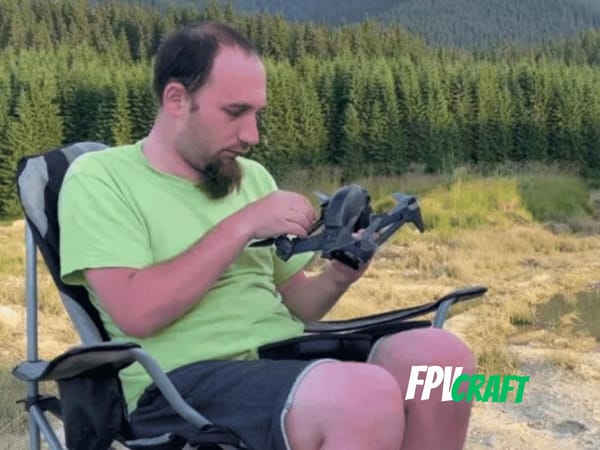What is the Best Camera Angle for a Cinewhoop Drone?
Cinewhoop drones are slower to fly than standard quad, best for indoor use and near people. But the camera angle is different. What's the best one?

A cinewhoop drone is a type of FPV drone that is much safer to fly around people, objects, indoors, inside a forest, etc., because of the duct guards it has for protection.
But a cinewhoop drone may share different settings and camera angles than a regular FPV drone.
What is the best camera angle for a cinewhoop drone?
We recommend setting a camera angle of 5 to 10 degrees for indoor use and up to 25 degrees for outdoor flights with your cinewhoop. I always found the 15-degree camera angle to be the sweet spot.
A microdrone can have a higher degree camera angle due to its smaller size and weaker motors.
In this article, I want to extend this information and help you decide which camera angle to choose for your cinewhoop, depending on your flight intentions.
What is the camera angle in an FPV drone?
To fly an FPV drone, you will have to set a camera angle from zero degrees on a horizontal plane all the way up, depending on what you use a drone for.
This is a positive degree numbered, and the highest recommended is around 45 degrees for racing.
But a cinewhoop drone is much slower than a racing drone and is made for safer types of flights.
That’s why its camera angle has to be lowered to have a controllable drone for smooth and slow flights.
When you fly your FPV drone and see in the goggles the horizon line with a specific camera angle, the drone will incline that many degrees facing forward in order to fly.
The higher the camera angle, the more inclination the FPV drone will have, hence, the higher the speed.
While standard GPS drones can be flown without a camera angle as this is adjustable in flight due to stabilization and hovering systems, setting a camera angle for an FPV drone is mandatory.
And a cinewhoop is an FPV drone.
» READ MORE: What Is the Best Camera Angle to Fly Your FPV Drone
What is a cinewhoop drone and is it safe to fly?
It is an FPV drone with strong frames (duct guards) around the propellers and motors, protecting them from any impacts or objects.
In this case, if you hit someone with a cinewhoop drone, the worst that can happen is to suffer from the impact of the drone, but the propellers won’t reach or harm that person.
Moreover, if flying inside the forest with a cinewhoop drone, you can fly in taller grass, between the branches of a tree, and even get through all foresty obstacles.
This is because the duct guard will protect anything from touching the propellers.
Cinewhoop drones are also most recommended for indoor flights, flying inside a hall or bowling alley because of the lower risk of harming someone or damaging property.
Remember, without those duct guards, a cinewhoop will simply be a standard FPV drone, and the propellers can badly harm someone or damage objects.
Camera angle for indoor use
When you want to fly your cinewhoop drone indoors, you need to fly at slower speeds.
Suppose you fly in acro mode, and even in level or horizon mode, you need to set a lower camera angle.
The best camera angles I have found for indoor use for a standard cinewhoop (e.g., 3 to 5 inches) are between 5 and 10 degrees.
If you set more, the drone can accelerate too much, and it will be hard to control it.
» READ MORE: How to Learn FPV in Simulators (Ultimate Guide)
Micro cinewhoop vs. standard-sized cinewhoop camera angle
The size of the cinewhoop will matter when flying slowly and smoothly.
The larger the drone is, the harder it will be to fly such a drone in tight spaces.
Many micro cinewhoop drones can be flown indoors or outdoors on a limited range to practice and have fun.
Usually, because of their small size in nature and weaker motors, some microwhoops come with a fixed camera angle of around 30 degrees.
Although this may seem much for a standard-sized cinewhoop, for a micro drone, it is something normal.
Some of the microdrones will allow you to adjust the camera angles, and if you can do it, in this case, 20-25 degrees, it is the best for excellent control around.
» READ MORE: DJI Avata vs. DJI FPV (In-Depth Comparison)
Camera angle for forest roams with a cinewhoop
If you plan to fly inside a forest, which is a common approach from FPV pilots with their cinewhoop, you have to set a camera angle for slightly higher speeds than indoor use but lower than flying long-range.
I have found that in the forest and for general usage, a 15-degree camera angle would be the best to use.
Personally, I always found 15 degrees to be a sweet spot for such drones, not only for forest flights but also for outdoor or exploring types of flights.
Remember, this camera angle is merely a guideline; you have to find your own from this point if you don’t feel it works right for your cinewhoop drones.
While some pilots prefer a more inclined angle for their cinewhoop cameras, others do the opposite.
Long-range cinewhoop flights camera angle
If you want to fly your cinewhoop for long range (as long as this is capable of that), then you will have to reach higher speeds but still be in control if you have to hover or slowly explore the surroundings.
Under these circumstances, a camera angle of 25 degrees for your cinewhoop may be the best approach.
Be aware that because of the duct guards, there will be a lot of air friction, affecting the ability of a cinewhoop to fly at higher speeds and remain stable all the way.
On one of the other posts, I wrote an article about DJI Avata’s camera angle and asked a few pilots what camera angles they usually use with this drone.
Active FPV, a YouTuber who often used to fly DJI Avata, mentioned he uses a camera angle between 22 and 28 degrees for cinematic long-range cruising and flights.
» READ MORE: 27 FPV Tips to Know Before Flying FPV Drones
Can you use a 0-degree camera angle on your cinewhoop?
You can use a zero-degree camera angle on your cinewhoop or any FPV drone, for that matter, but I personally classified it as an experimental type of flight.
Flying an FPV drone at zero degrees, the drone should hover if you hold the horizon line in the center of the screen.
But I always found the yaw and roll act unnaturally in this situation, and it is much harder to maneuver an FPV drone at zero degrees, even by the more advanced pilots.
However, suppose you manage to master the zero-degree camera angle. In that case, this applies best to cinewhoops rather than standard FPV quads and will be a unique way to control your drone in any direction and at any speed.
What camera angle do I use?
When I fly cinewhoop, I like to have a stable camera angle of about 15 degrees and try to manage different types of flights from indoors at low speeds to outdoors at higher speeds.
This is because once you get used to a camera angle for a drone, you will train your muscle memory, and instinctively, you can fly a drone much better than swapping camera angles all the time.
» READ MORE: What is the Best Liftoff Simulator Camera Angle to Learn FPV




